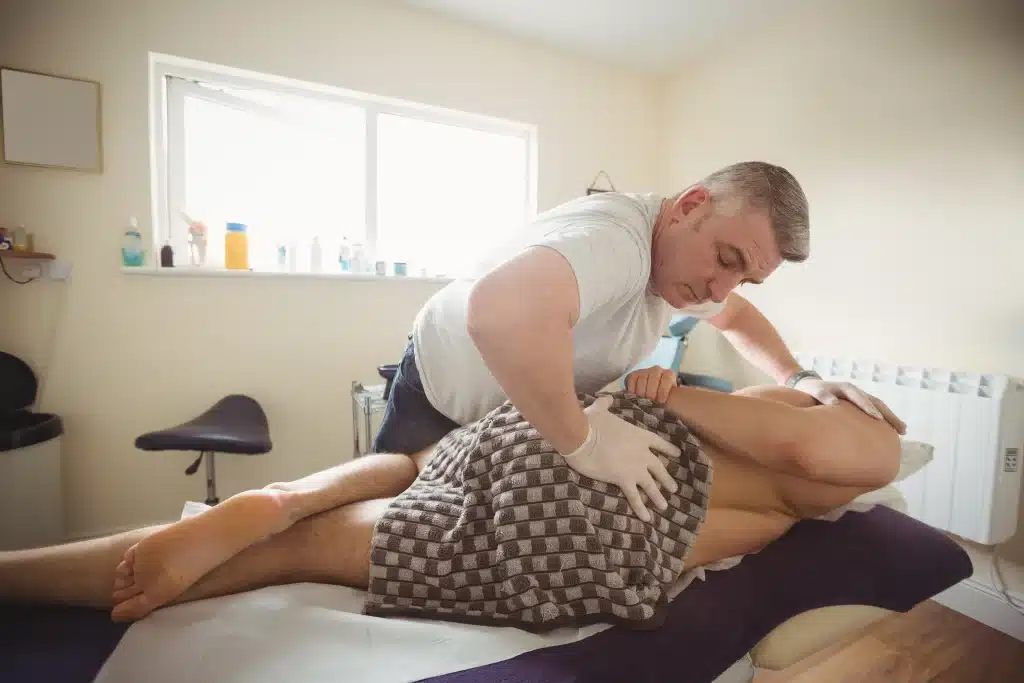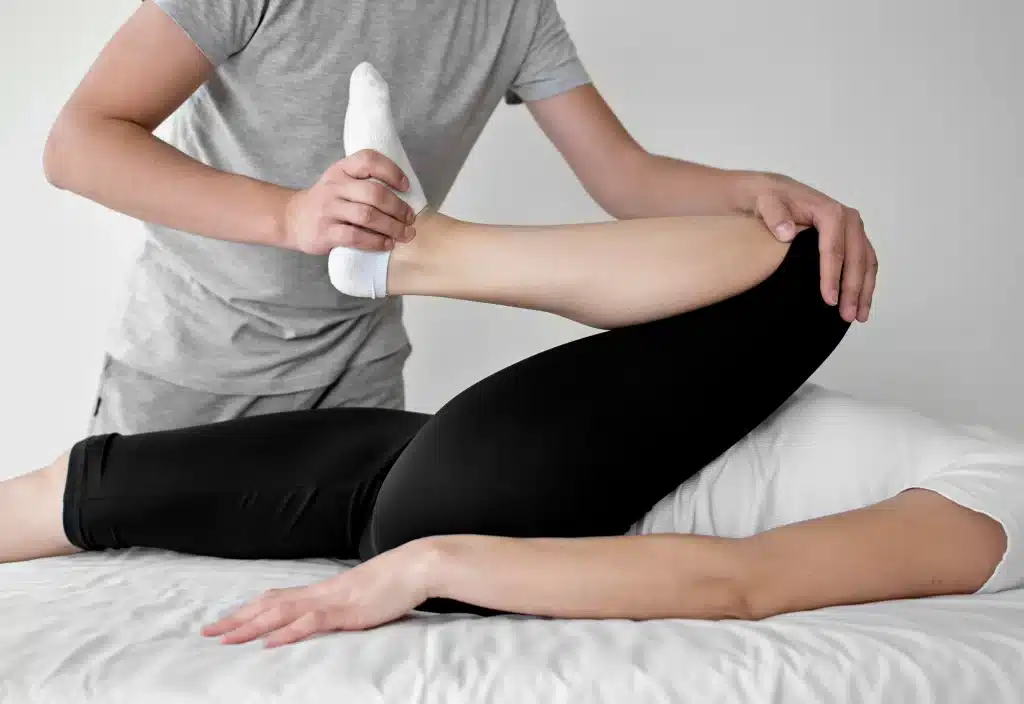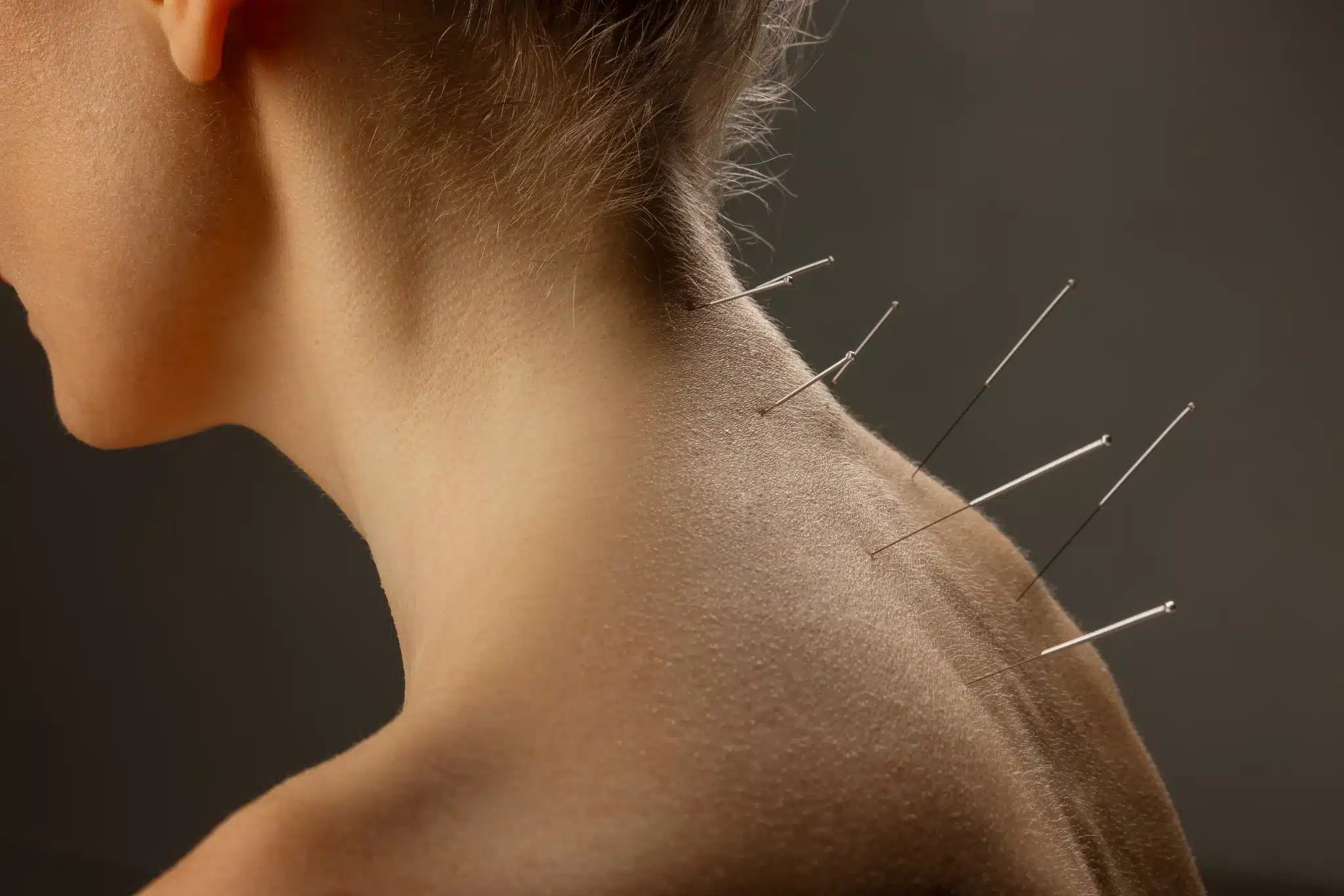Myofascial release near me therapy is a soft, steady massage that targets tight muscles and tissues. It finds and works on trigger points or knots in these tissues. This therapy helps ease chronic pain, boosts movement, and fixes problems from injuries, stress, trauma, overuse, and bad posture.
Key Takeaways
- Myofascial release therapy focuses on relieving pain in myofascial tissues, the thick connective tissues supporting muscles.
- Tight myofascial tissue restricts movement, leading to stiffness and discomfort.
- Regular myofascial release therapy can improve range of motion, reduce soreness, and help relieve stress.
- Self-myofascial release methods include using fingers, foam rollers, or balls to apply gentle pressure.
- Myofascial release therapy may be an option for those seeking relief from chronic or short-term back pain.

Understanding Myofascial Release and Its Importance
Myofascial tissue is a network of connective tissue in our body. It supports muscles, joints, bones, and organs. This tissue has layers with liquid between them, allowing for movement.
When this tissue gets tight or restricted, it can cause myofascial pain.
What is Myofascial Tissue?
The myofascial tissue network is key to our body's structure and function. It helps muscles transmit force and provides stability to joints. It also helps our body move smoothly.
When this network gets disrupted, it can lead to musculoskeletal problems. This includes chronic back pain, headaches, and limited movement.
To gain deeper insights into chronic back pain, click here to explore more.
How Myofascial Pain Develops
Myofascial pain often comes from trigger points. These are hyperirritable spots in the tissue. They can develop from overuse, injury, or stress.
When these trigger points are activated, they can cause pain, muscle tightness, and limited mobility.
Common Areas of Myofascial Tension
Myofascial tension and pain can occur in many areas. These include:
- Arms
- Calves
- Feet
- Head
- Hips
- Jaw
- Lower back
- Neck
- Quads
- Shoulders
Understanding myofascial tissue and myofascial pain is key. It helps us develop effective treatments for musculoskeletal conditions.

Health Benefits of Myofascial Release
Myofascial release is a powerful technique that offers many health benefits. It helps relieve chronic pain, improves movement, and aids in the body's healing. This hands-on method is very effective.
One big advantage of myofascial release is its ability to manage and reduce chronic pain. It works by applying gentle pressure to tight spots in the body. These spots are often found in the neck, shoulders, and lower back.
A study with 74 fibromyalgia patients showed great results. Those who got massage-myofascial release therapy saw big improvements. They felt less anxious, slept better, had less pain, and felt better overall. These benefits lasted even after a month.
Myofascial release also enhances range of motion. It helps muscles work better and improves blood flow. This is great for athletes or anyone recovering from an injury.
Dr. Adams suggests doing myofascial release daily for 2-5 minutes. This can lead to better circulation, less stress, and a sense of calm. It's a simple way to improve your health.
| Benefit | Impact |
|---|---|
| Pain Relief | Myofascial release can help alleviate chronic pain in various areas of the body, such as the neck, shoulders, and lower back. |
| Improved Range of Motion | By restoring normal muscular length and encouraging blood flow, myofascial release can enhance range of motion and support the body's natural healing processes. |
| Reduced Stress and Tension | Myofascial release techniques can promote relaxation, improve circulation, and release accumulated tension in the body. |
| Enhanced Recovery | Regular myofascial release can assist in the natural recovery of tissues, making it beneficial for athletes and individuals recovering from injury. |
Professional Myofascial Release Techniques
Myofascial release is a therapy that helps manage muscle pain. Trained therapists use different methods to target tight areas in the myofascial tissue. These methods can reduce pain, improve movement, and help muscles recover faster.
Manual Pressure Techniques
Myofascial release massage uses gentle, sustained pressure to find and release tight spots in the fascia. This hands-on method helps the tissue rehydrate, improves blood flow, and eases trigger points. Therapists use both light and deep pressure to get the best results.
Tool-Assisted Release Methods
Tools like foam rollers and massage balls are also used. They help reach and relieve deep tissue, making muscles more flexible. These tools let patients continue the therapy at home between sessions.
Treatment Duration and Frequency
Myofascial release therapy can be intense but is often worth it. How long and how often you need treatment depends on your condition and how you respond. Regular sessions are usually needed for lasting relief, as releasing fascial restrictions is a gradual process.
| Technique | Benefits |
|---|---|
| Foam Rolling | Reduces muscle sorenessIncreases flexibilityImproves blood circulation |
| Trigger Point Therapy | Alleviates muscle painEnhances muscle functionReduces referred pain |
| Massage Ball Techniques | Targets hard-to-reach areasProvides deep tissue reliefImproves muscle flexibility |
Myofascial release therapy is becoming a key treatment for chronic pain, especially back pain. Research shows it can help with a range of issues, like better movement, less inflammation, more joint mobility, and better sleep.
"Myofascial release is emerging as a strategy with a solid evidence base and tremendous potential as an effective treatment."
Self-Administered Myofascial Release at Home
People can do self-massage techniques at home to ease muscle tension. Studies show that a home program can reduce neck and upper back pain. It uses ischemic pressure and sustained stretching.
Self-myofascial release is great for keeping your body healthy. It can help with chronic pain, headaches, and more. It's a key part of staying fit and mobile.
Techniques for Self-Myofascial Release
Using a foam roller or massage ball is helpful for self-myofascial release. It keeps muscles and tissues flexible. But, avoid being too aggressive to prevent muscle problems.
Foam rollers are great for self-myofascial release. You can find them at sports stores, online, or from healthcare pros.
- Focus on gentle pressure for 1-2 minutes on each muscle group. This lets the tissue relax and expand slowly.
- Use ischemic pressure by holding the roller or ball on tight spots for 30-60 seconds. Then, release and move to the next spot.
- Do sustained stretching by rolling slowly over the muscle. Pause on tender spots.
"Self-myofascial release exercises are typically performed for 1-2 minutes each, focusing on gentle pressure and relaxation to allow the connective tissue to relax and expand slowly."
Adding self-massage and home myofascial release to your routine can prevent muscle stiffness. It also improves mobility and overall well-being.
FAQ
What is myofascial release therapy?
Myofascial release therapy is a soft, steady massage. It targets tight spots in muscles and tissues. It finds knots and applies gentle pressure until the tension goes away.
How does myofascial release therapy alleviate chronic pain?
It helps by fixing problems from injuries, stress, and bad posture. It makes moving easier and helps the body heal naturally. This leads to less pain and soreness.
What are the signs that someone needs myofascial release therapy?
You might need it if you have muscle tightness or can't move as well as you should. Also, if you're always in pain or sore. It's good for chronic pain in many areas like arms, calves, and back.





